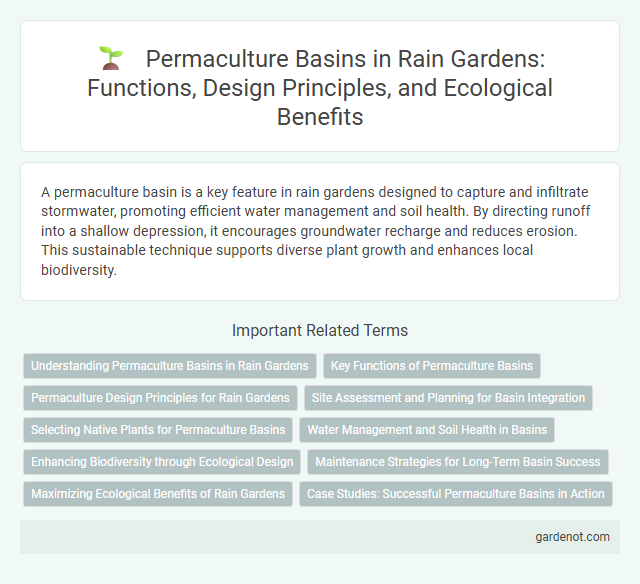A permaculture basin is a key feature in rain gardens designed to capture and infiltrate stormwater, promoting efficient water management and soil health. By directing runoff into a shallow depression, it encourages groundwater recharge and reduces erosion. This sustainable technique supports diverse plant growth and enhances local biodiversity.
Understanding Permaculture Basins in Rain Gardens
Permaculture basins in rain gardens function as shallow, strategically designed depressions that capture and infiltrate stormwater runoff, enhancing water retention and soil moisture. These basins leverage natural landscape contours to slow water flow, maximizing groundwater recharge while reducing erosion and pollution. Incorporating native plants within the basin improves ecological balance, supports biodiversity, and aids in nutrient cycling for sustainable water management.
Key Functions of Permaculture Basins
Permaculture basins serve as effective water catchment and infiltration systems that enhance soil moisture retention and reduce erosion in sustainable landscaping. They promote groundwater recharge by slowing surface runoff, supporting plant health, and fostering biodiversity through habitat creation. These basins also filter pollutants from stormwater, improving water quality and contributing to resilient ecosystem management.
Permaculture Design Principles for Rain Gardens
Permaculture basins in rain garden design utilize ecological principles such as water harvesting, soil health improvement, and biodiversity enhancement to create sustainable, self-regulating landscapes. Incorporating swales, keyline designs, and mulching techniques optimizes water infiltration and retention, reducing runoff and promoting plant resilience. Emphasizing observation, edge effect, and diversity ensures that rain gardens function as efficient water catchments and thriving microhabitats within permaculture systems.
Site Assessment and Planning for Basin Integration
Site assessment for permaculture basin integration involves evaluating soil permeability, topography, and existing vegetation to ensure optimal water catchment and infiltration. Detailed mapping of water flow patterns and seasonal rainfall data informs basin placement, minimizing erosion and maximizing groundwater recharge. Planning also includes selecting appropriate native plants to stabilize soil and enhance biodiversity within the rain garden ecosystem.
Selecting Native Plants for Permaculture Basins
Selecting native plants for permaculture basins enhances water retention and soil quality by utilizing species adapted to local climate and hydrology. Deep-rooted perennials, such as sedges, rushes, and native wildflowers, stabilize soil and promote natural filtration of runoff in rain gardens. Incorporating a diverse mix of native flora maximizes ecosystem resilience, supports pollinators, and reduces maintenance needs by aligning with the basin's natural water cycle.
Water Management and Soil Health in Basins
Permaculture basins enhance water management by capturing and directing seasonal rainfall to maximize infiltration and reduce runoff, promoting sustainable water cycles. These basins improve soil health through increased organic matter retention and microbial activity, fostering nutrient-rich, well-aerated soil structures ideal for plant growth. Proper design and maintenance of permaculture basins support water conservation and create resilient ecosystems by stabilizing soil moisture levels and preventing erosion.
Enhancing Biodiversity through Ecological Design
Permaculture basins serve as rain gardens designed to enhance biodiversity by creating microhabitats that support diverse plant and animal species. These engineered systems capture and filter stormwater, promoting soil health and fostering ecological resilience. Incorporating native plants and layered vegetation structures, permaculture basins improve habitat complexity and encourage beneficial insects, birds, and soil microorganisms.
Maintenance Strategies for Long-Term Basin Success
Effective maintenance of permaculture basins involves regular inspection for sediment buildup to prevent clogging and ensure optimal water infiltration. Vegetation management, including selective pruning and replanting with native species, enhances soil stability and supports biodiversity. Integrating mulch layers and monitoring water flow patterns contribute to long-term basin functionality and resilience against erosion.
Maximizing Ecological Benefits of Rain Gardens
Permaculture basins enhance rain garden efficiency by strategically capturing and filtering stormwater runoff, promoting groundwater recharge and habitat creation. These basins incorporate native plants that stabilize soil and support biodiversity, while reducing erosion and nutrient runoff into waterways. Maximizing ecological benefits, permaculture basins optimize water retention and improve urban ecosystem health through sustainable landscape design.
Case Studies: Successful Permaculture Basins in Action
Permaculture basins effectively manage stormwater by capturing runoff and promoting groundwater recharge, as demonstrated in various case studies worldwide. In Australia, the Maleny Rainforest, using permaculture basins, restored native vegetation and reduced soil erosion significantly within three years. Similar success in urban settings is observed in Portland, Oregon, where permaculture basins decreased neighborhood flooding by 40% while enhancing local biodiversity.
Permaculture basin Infographic

 gardenot.com
gardenot.com